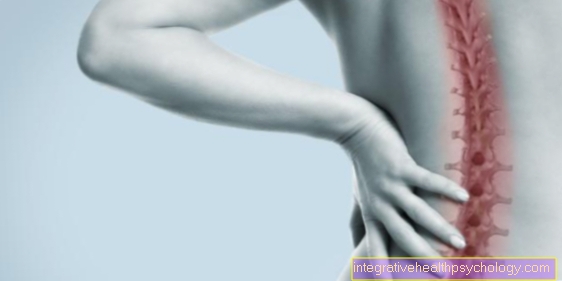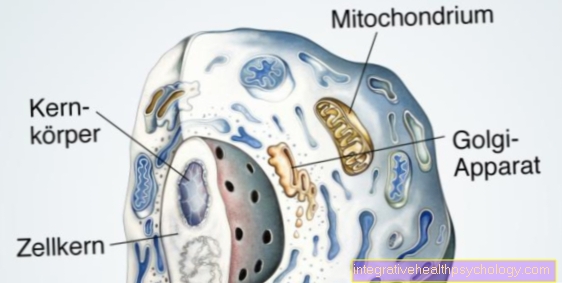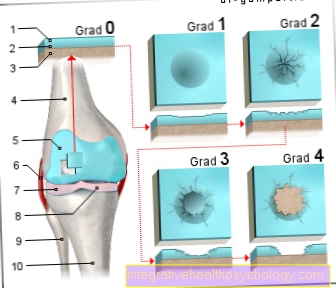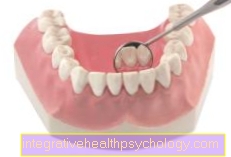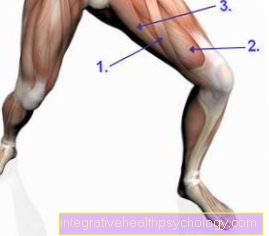Diseases of the esophagus
The esophagus can be affected by a number of different diseases. Symptoms such as bad breath or difficulty swallowing can provide important clues in the search for the underlying disease.
The therapy options are varied and always depend on the diagnosed disease.

Damage and injury to the mucous membrane
heartburn
The most common disease of the esophagus is caused by the backflow of gastric acid due to reduced muscle occlusion between the esophagus and the stomach entrance. The stomach acid causes inflammation of the lining of the esophagus.
The patient's complaints are frequent belching, so-called heartburn and a recurring burning pain behind the breastbone. In medical terminology, this is referred to as reflux disease or reflux esophagitis.
Further information on the subject can be found at: Reflux disease
Esophagitis
An esophagitis (lat. Esophagitis) means inflammation of the lining of the esophagus. This inflammation can be caused by various causes, such as bacteria. The most common cause, however, is the recurrence of heartburn. The mucous membrane of the esophagus is very sensitive to stomach acid, causing it to become inflamed and irreversibly changed.
You can find more information under our topic: Esophagitis
Mallory-Weiss Syndrome
The Mallory-Weiss syndrome is a clinical picture that is characterized by bleeding from the torn mucous membrane of the esophagus. The affected patients suffer from severe upper abdominal pain and vomit blood, among other things (Hematemesis).
The Mallory-Weiss syndrome is caused by repeatedly vomiting. The mucous membrane is damaged in this way and tears open in some places. Alcoholism in particular is characterized by frequent vomiting, which is why the syndrome often occurs in alcoholic patients. But reflux esophagitis can also lead to this clinical picture.
You can read more about this topic: Mallory-Weiss Syndrome
Esophageal variceal bleeding
Esophageal variceal bleeding describes profuse bleeding from the varicose veins of the esophagus. The varicose veins are secondary. This means that they arise as a result of an underlying disease such as liver dysfunction. The pressure in the venous system rises sharply and life-threatening bleeding can occur, which should be treated immediately by a doctor.
Esophageal varices are usually not symptomatic and are only discovered when there is bleeding.
Further information is available under our topic: Esophageal variceal bleeding
Diseases of the esophagus

Achalasia
Achalasia describes a disorder of the muscles of the esophagus, which is associated with a decrease in the tone of the muscles. This leads to a deteriorated opening of the sphincter. In this way the swallowing process of the esophagus is impaired and the chyme cannot be carried into the stomach. It only empties when the pressure due to pent-up food is high enough and the sphincter then opens it.
Affected patients complain of difficulty swallowing, weight loss and pain behind the sternum.
Read more about this here: Achalasia
Esophageal spasm
A similar disease, but viewed as a separate disease, is diffuse esophageal spasm. Simultaneous and repeated contractions of the smooth muscles of the esophagus occur. The normal wave-like movement that transports food towards the stomach is only found in the upper section, the rest of the esophagus contains numerous windings and bulges and looks like a corkscrew on X-ray examinations with contrast media.
As a result of these deformities, the esophagus is shortened enormously and the stomach is also pulled up through the diaphragm.
Narrowing of the esophagus
This clinical picture is caused by a narrowing of the esophagus, which means that food can no longer be transported adequately. Usually the lower section is affected. There are many known causes for the development. Most often it occurs in connection with reflux disease. But inflammatory reactions triggered by bacteria can also lead to this clinical picture.
The patients complain of swallowing disorders (Dysphagia) and pain.
Further information on this topic can be found at: Narrowing of the esophagus
Reflux
Reflux disease describes the flow of stomach acid back into the esophagus. The most common cause of this is incomplete closure of the lower esophageal sphincter. Other causes can be pregnancy or surgery.
Inflammation of the esophagus or precancerous lesions (precursors of cancer) can occur as a result of reflux.
The main symptom of reflux disease is heartburn. A burning pain behind the breastbone that occurs especially after meals, at night and when lying down. A feeling of pressure behind the breastbone can also occur.
Learn more about the topic Reflux diseases
Esophageal cancer
Another important and not uncommon disease is esophageal cancer.
Patients with risk factors such as alcohol, cigarette consumption and an unbalanced diet have a higher risk of developing the disease.
Other diseases of the esophagus also contribute to the development of cancer. Reflux disease in particular, which in many cases leads to frequent inflammation of the mucous membrane, increases the risk of cancer cells forming due to changes in the mucous membrane. Such changes or remodeling processes of the mucous membrane are generally called Metaplasia denotes and favor the development of cancer.
Patients often only notice that there are changes when they are more severely impaired, such as swallowing disorders. Hoarseness, pressure and pain behind the sternum and B symptoms can also occur. The diagnosis of esophageal cancer is usually based on a detailed anamnesis and various examinations.
Find out more about the topic here Esophageal cancer
Esophageal diverticulum
Another rare disease of the esophagus is the anatomical sacs of the esophagus. They are called esophageal diverticula and appear as bulges of different sizes in different parts of the esophagus. This bulge can occur due to a muscularly weakened gap and a simultaneous increase in pressure in the abdomen, such as when lifting heavy objects.
The patient usually only notices symptoms when the diverticulum is a certain size. Difficulty swallowing occurs more frequently, which can lead to the choking up of undigested food. Another unpleasant symptom is intense bad breath when chunks of food remain in these protuberances and are not swallowed down. As a result, patients constantly have the feeling of having a lump in their throat. The diverticula can be diagnosed by means of an examination in which the esophagus is shown with an endoscope and possibly also a contrast medium.
Read more on the topic Esophageal diverticulum
Sliding hernia
When part of the stomach slides through the diaphragm into the chest, this is known as a sliding hernia, diaphragmatic hernia, or hiatal hernia. Symptoms are similar to those of achalasia. Diaphragmatic hernias can also be the sole cause of heartburn and belching.
In most cases, however, sliding hernias are without symptoms and only complicated forms can cause more serious complications such as entrapment, bleeding and tears. '
Depending on the size of the hernia and the size of the stomach that has moved into the chest, an operation is performed. The part of the stomach is shifted back into the abdomen and finally also fixed with a sleeve of its own stomach tissue.



